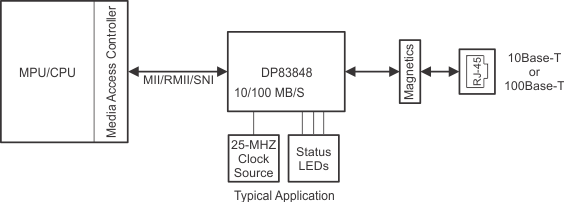ZHCSDF9 February 2015 DP83848-HT
PRODUCTION DATA.
- 1 特性
- 2 应用范围
- 3 描述
- 4 典型系统图
- 5 修订历史记录
- 6 Bare Die Information
- 7 Specifications
-
8 Detailed Description
- 8.1 Overview
- 8.2 Functional Block Diagram
- 8.3
Feature Description
- 8.3.1 100BASE-TX Transmitter
- 8.3.2 100BASE-TX Receiver
- 8.3.3
10BASE-T Transceiver Module
- 8.3.3.1 Operational Modes
- 8.3.3.2 Smart Squelch
- 8.3.3.3 Collision Detection and SQE
- 8.3.3.4 Carrier Sense
- 8.3.3.5 Normal Link Pulse Detection/Generation
- 8.3.3.6 Jabber Function
- 8.3.3.7 Automatic Link Polarity Detection and Correction
- 8.3.3.8 Transmit and Receive Filtering
- 8.3.3.9 Transmitter
- 8.3.3.10 Receiver
- 8.3.4 Reset Operation
- 8.4 Device Functional Modes
- 8.5 Programming
- 8.6
Register Maps
- 8.6.1 Register Block
- 8.6.2
Register Definition
- 8.6.2.1 Basic Mode Control Register (BMCR)
- 8.6.2.2 Basic Mode Status Register (BMSR)
- 8.6.2.3 PHY Identifier Register 1 (PHYIDR1)
- 8.6.2.4 PHY Identifier Register 2 (PHYIDR2)
- 8.6.2.5 Auto-Negotiation Advertisement Register (ANAR)
- 8.6.2.6 Auto-Negotiation Link Partner Ability Register (ANLPAR) (BASE Page)
- 8.6.2.7 Auto-Negotiation Link Partner Ability Register (ANLPAR) (Next Page)
- 8.6.2.8 Auto-Negotiate Expansion Register (ANER)
- 8.6.2.9 Auto-Negotiation Next Page Transmit Register (ANNPTR)
- 8.6.3
Extended Registers
- 8.6.3.1 PHY Status Register (PHYSTS)
- 8.6.3.2 MII Interrupt Control Register (MICR)
- 8.6.3.3 MII Interrupt Status and Miscellaneous Control Register (MISR)
- 8.6.3.4 False Carrier Sense Counter Register (FCSCR)
- 8.6.3.5 Receiver Error Counter Register (RECR)
- 8.6.3.6 100 Mb/s PCS Configuration and Status Register (PCSR)
- 8.6.3.7 RMII and Bypass Register (RBR)
- 8.6.3.8 LED Direct Control Register (LEDCR)
- 8.6.3.9 PHY Control Register (PHYCR)
- 8.6.3.10 10Base-T Status/Control Register (10BTSCR)
- 8.6.3.11 CD Test and BIST Extensions Register (CDCTRL1)
- 8.6.3.12 Energy Detect Control (EDCR)
- 9 Application and Implementation
- 10Power Supply Recommendations
- 11Layout
- 12器件和文档支持
- 13机械封装和可订购信息
1 特性
- 低功耗 3.3V,0.18μm CMOS 技术
- 低功耗:小于 270mW(典型值)
- 3.3V MAC 接口
- 针对 10/100Mb/s 的自动 MDIX
- 能量检测模式
- 25MHz 时钟输出
- SNI 接口(可配置)
- RMII 修订版本 1.2 接口(可配置)
- MII 串行管理接口(MDC 和 MDIO)
- IEEE 802.3u MII
- IEEE 802.3u 自动协商和并行检测
- IEEE 802.3u ENDEC,10BASE-T 收发器和滤波器
- IEEE 802.3u PCS,100BASE-TX 收发器和滤波器
- IEEE 1149.1 JTAG
- 集成了符合 ANSI X3.263 标准的双绞线物理介质相关 (TP-PMD) 物理子层,该子层具有自适应均衡和基线漂移补偿
- 长达 150 米的无故障运行
- 可编程 LED 支持链路,10/100Mb/s 模式,活动和冲突检测
- 针对完整 PHY 状态的单寄存器访问
- 10/100Mbps 数据包 BIST(内置自检)
- 支持国防、航天和医疗应用
- 受控基线
- 同一组装和测试场所
- 同一制造场所
- 扩展级温度范围(–55°C 至 150°C)
- 延长的产品生命周期
- 延长的产品变更通知
- 产品可追溯性
2 应用范围
- 汽车和运输
- 工业控制和工厂自动化
- 通用嵌入式应用
3 描述
要求以太网连接的应用的数量持续增加。 随着此类需求的增加,增加的市场需求是应用要求的一个变化。 DP83848 被设计用于在恶劣环境中实现以太网连接。 这款器件非常适合应用于恶劣环境,例如无线远程基站、汽车、运输和工业控制类应用。
DP83848 是一款高度可靠且功能丰富的稳健耐用型器件,其包含有增强型静电放电 (ESD) 保护、介质无关接口 (MII) 和简化的介质无关接口 (RMII),可在选择 MPU 方面提供极大的灵活性。
DP83848 特有集成的子层来支持 10BASE-T 和 100BASE-TX 以太网协议,这样确保了与所有其他基于标准的以太网解决方案的兼容性和互操作性。
器件信息(1)
| 器件型号 | 芯片 | 芯片尺寸(标称值) |
|---|---|---|
| DP83848-HT | KGD (49) | 1592µm × 1532µm |
- 要了解所有可用封装,请见数据表末尾的可订购产品附录。
4 典型系统图
